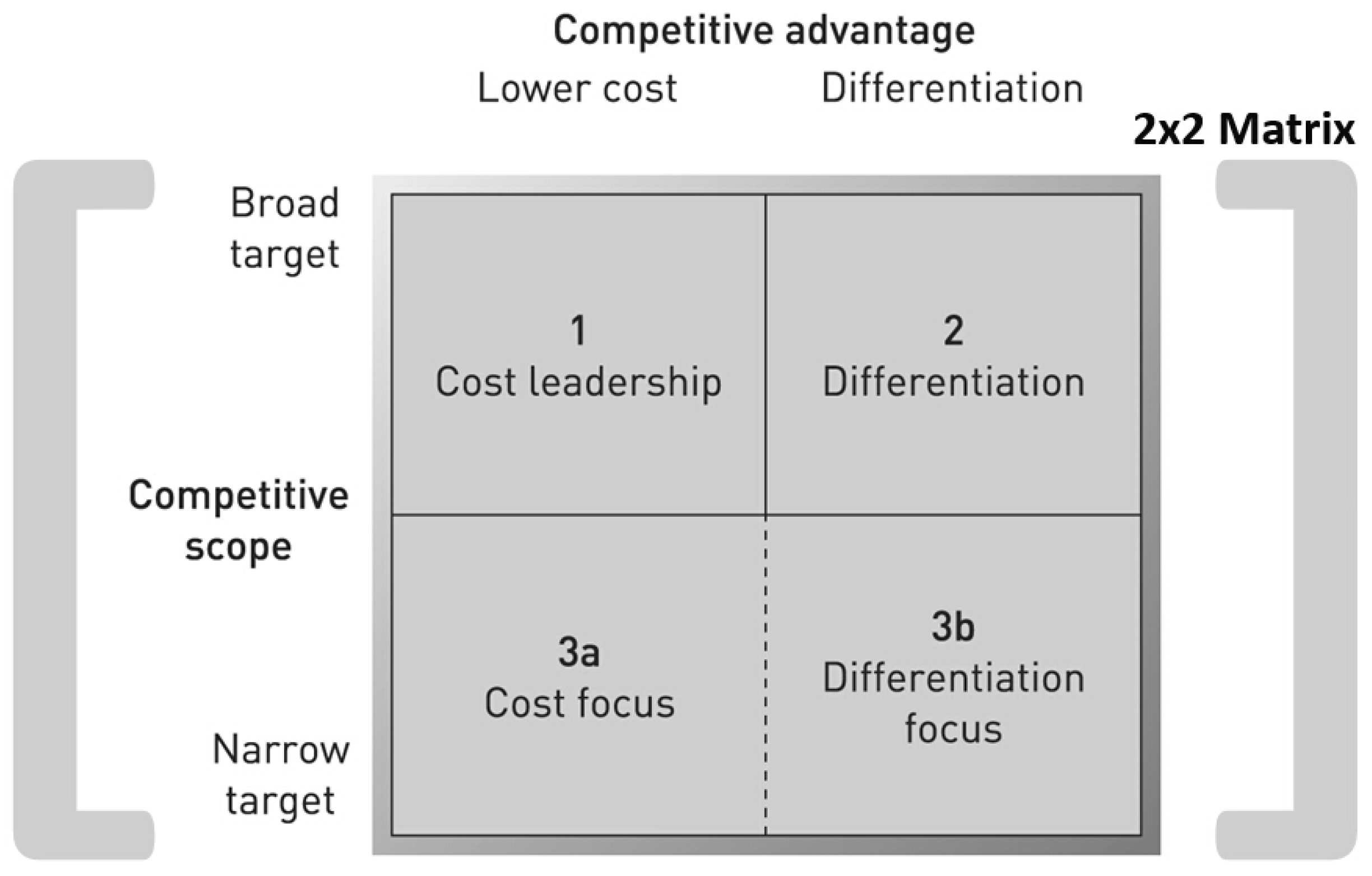Advanced Mathematical Business Strategy Formulation Design
Abstract
:1. Introduction
2. Literature Review
3. The Explicit Mathematical Model
3.1. Preliminaries
- (i)
- is a linear functional with fixed points at constant functions;
- (ii)
3.2. General Framework for Mathematical Strategy Formulation
3.3. Strategy Shifts under Memoryless Observation
3.4. Useful Tips for Theoretical Modeling
4. BCG Growth-Share Matrix Reloaded
5. Conclusions
Funding
Acknowledgments
Conflicts of Interest
Appendix A. Proof of Lemma 1
Appendix B. Proof of Lemma 2
References
- Hitt, M.A.; Ireland, R.D. Concepts Strategic Management: Competitiveness & Globalization, 9th ed.; South-Western Cengage Learning: Mason, OH, USA, 2011. [Google Scholar]
- Johnson, G.; Whittington, R.; Scholes, K.; Angwin, D.; Regner, P. Exploring Strategy Text and Cases, 11th ed.; Pearson: Harlow, UK, 2017. [Google Scholar]
- Wheelen, T.L.; Hunger, J.D. Strategic Management and Business Policy, 13th ed.; Pearson: Upper Saddle River, NJ, USA, 2012. [Google Scholar]
- Juneja, P. Steps in Strategy Formulation Process. 2019. Available online: https://www.managementstudyguide.com/strategy-formulation-process.htm (accessed on 1 May 2019).
- Salor Foundation, Strategy Formulation. 2019. Available online: https://resources.saylor.org/wwwresources/archived/site/wp-content/uploads/2013/09/Saylor.orgs-Strategy-Formulation.pdf (accessed on 1 May 2019).
- Lederman, L.L. Foresight Activities in the U.S.A.: Time for a Re-Assessment? Long Range Plan. 1984, 17, 41–50. [Google Scholar] [CrossRef]
- Porter, M.E. From Competitive Advantage to Corporate Strategy. Readings in Strategic Management; Palgrave: London, UK, 1989; pp. 234–255. [Google Scholar]
- Bowman, C.; Faulkner, D. Competitive and Corporate Strategy; Irwin: London, UK, 1997. [Google Scholar]
- Ansoff, I. Strategies for Diversification. Harv. Bus. Rev. 1957, 35, 113–124. [Google Scholar]
- Hedley, B. Strategy and the Business Portfolio. Long Range Plan. 1977, 10, 9–15. [Google Scholar] [CrossRef]
- Crossan, M. Strategic Analysis and Action; W09374-PDF-ENG; Harvard Business Publishing: Brighton, MA, 2011; 43p. [Google Scholar]
- Dshalalow, J.H. First excess level process. In Advances in Queueing; CRC Press: Boca Raton, FL, USA, 1995; pp. 244–261. [Google Scholar]
- Dshalalow, J.H.; Ke, H.-J. Layers of noncooperative games. Nonlinear Anal. 2009, 71, 283–291. [Google Scholar] [CrossRef]
- Dshalalow, J.H. Random Walk Analysis in Antagonistic Stochastic Games. Stoch. Anal. Appl. 2008, 26, 738–783. [Google Scholar] [CrossRef]
- Dshalalow, J.H.; Huang, W.; Ke, H.J.; Treerattrakoon, A. On Antagonistic Game with a Constant Initial Condition Marginal Functionals and Probability Distributions. Nonlinear Dyn. Syst. Theory 2016, 16, 268–275. [Google Scholar]
- Dshalalow, J.H.; Iwezulu, K.; White, R.T. Discrete Operational Calculus in Delayed Stochastic Games. Neural Parallel Sci. Comput. 2016, 24, 55–64. [Google Scholar]
- Kim, S.-K. Enhanced Design of Stochastic Defense System with Mixed Game Strategies. In Game Theory for Networking Applications; Springer: Berlin, Germany, 2018; pp. 107–117. [Google Scholar]
- Kim, S.-K. Blockchain Governance Game. Comput. Indu. Eng. 2019, 136, 373–380. [Google Scholar] [CrossRef] [Green Version]
- Kim, S.-K. Strategic Alliance for Blockchain Governance Game. Probab. Eng. Informational Sci. 2020. [Google Scholar] [CrossRef]
- Kim, S.-K. A Versatile Stochastic Duel Game. Mathematics 2020, 8, 678. [Google Scholar] [CrossRef]
- Kim, S.-K. Antagonistic One-To-N Stochastic Duel Game. Mathematics 2020, 8, 1114. [Google Scholar] [CrossRef]
- Hanlon, A. How to Use the BCG Matrix Model. 2019. Available online: https://www.smartinsights.com/marketing-planning/marketing-models/use-bcg-matrix/ (accessed on 1 May 2019).
- Kenton, W. BCG Growth-Share Matrix. 2019. Available online: https://www.investopedia.com/terms/b/bcg.asp (accessed on 1 May 2019).
- Anderson, C. Values-Based Management. Acad. Mgt. Execc. 1997, 11, 25–46. [Google Scholar] [CrossRef]
- Weissenberger-Eibl, M.A.; Almeida, A.; Seus, F. A Systems Thinking Approach to Corporate Strategy Development. Systems 2019, 7, 16. [Google Scholar] [CrossRef] [Green Version]
- Kumar, M.; Tsolakis, N.; Agarwal, A.; Srai, J.S. Developing distributed manufacturing strategies from the perspective of a product-process matrix. Int. J. Prod. Econ. 2020, 219, 1–17. [Google Scholar] [CrossRef]
- Riley, J. Bowman’s Strategic Clock. 2016. Available online: https://www.tutor2u.net/business/reference/strategic-positioning-bowmans-strategy-clock (accessed on 1 May 2019).
- McKinsey & Company. McKinsey Quarterly. 2008. Available online: https://www.mckinsey.com/business-functions/strategy-and-corporate-finance/our-insights/enduring-ideas-the-ge-and-mckinsey-nine-box-matrix (accessed on 1 May 2019).
- Enalls, T. GE McKinsey Matrix: How to Apply It to Your Business. 2017. Available online: http://ideagenius.com/ge-mckinsey-matrix-apply-business/ (accessed on 1 May 2019).













| I | Dogs | The usual marketing advice here is to aim to remove any dogs from the product portfolio as they are a drain on resources. |
| II | Cows | The simple rule here is to “Milk these products as much as possible without killing the cow”. Often used for mature, well-established products. |
| III | Stars | The market leaders, though they require ongoing investment to sustain. They generate more ROI (return-of-investment) than other product categories. |
| IV | Question Marks | These products often require significant investment to push them into the star quadrant. |
© 2020 by the author. Licensee MDPI, Basel, Switzerland. This article is an open access article distributed under the terms and conditions of the Creative Commons Attribution (CC BY) license (http://creativecommons.org/licenses/by/4.0/).
Share and Cite
Kim, S.-K. Advanced Mathematical Business Strategy Formulation Design. Mathematics 2020, 8, 1642. https://doi.org/10.3390/math8101642
Kim S-K. Advanced Mathematical Business Strategy Formulation Design. Mathematics. 2020; 8(10):1642. https://doi.org/10.3390/math8101642
Chicago/Turabian StyleKim, Song-Kyoo (Amang). 2020. "Advanced Mathematical Business Strategy Formulation Design" Mathematics 8, no. 10: 1642. https://doi.org/10.3390/math8101642






